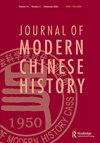Foreign experts in the People’s Republic of China: an historical review from the perspectives of modernization and globalization (1949-1966)
IF 0.1
4区 历史学
Q4 HISTORY
引用次数: 0
Abstract
ABSTRACT In the history of the People’s Republic of China we see two waves of foreign experts who contributed to China’s becoming a self-reliant, modern industrialized country. The first wave took place in the 1950s when experts from the Soviet Union and other Eastern Europe countries were dispatched to China. The second wave, beginning in the 1960s, was mainly driven by experts, workers and technicians from the Western capitalist countries. In the early days of the P. R. C, the arrival of a large number of Soviet experts precipitated the systems established by the CCP Central Committee and the State Council in order to manage issues related to the foreign experts. Under the leadership of a bureau within the State Council that was responsible for these issues, the system incorporated government organizations both at the central and local levels, including those established by Central ministries and commissions. Under the principle of “equal treatment,” the Chinese government made policies concerning payment and benefits for experts from capitalist countries, using as reference the standards observed in the Soviet Union and other East European countries in the mid-1950s. From the time when Soviet and East European experts departed China to 1966, the Chinese government still adhered to the principles of “seeking common ground” and “different approaches towards internal and external issues,” respectively. The approach of the Chinese government was largely cost efficient.在中华人民共和国的外国专家:现代化与全球化视角下的历史回顾(1949-1966)
在中华人民共和国的历史上,我们看到了两波外国专家,他们为中国成为一个自力更生的现代化工业化国家做出了贡献。第一波发生在20世纪50年代,当时苏联和其他东欧国家的专家被派往中国。第二次浪潮开始于20世纪60年代,主要由来自西方资本主义国家的专家、工人和技术人员推动。新中国成立之初,大批苏联专家的到来促使中共中央和国务院建立了管理外国专家问题的制度。在负责这些事务的国务院下属一个局的领导下,该系统将中央和地方各级政府机构包括中央部委设立的政府机构纳入其中。中国政府在“平等待遇”原则下,参照上世纪50年代中期苏联等东欧国家的标准,制定了资本主义国家专家的待遇政策。从苏联和东欧专家离开中国到1966年,中国政府仍然坚持“求同存异”和“对内对外不同”的原则。中国政府的做法在很大程度上具有成本效益。
本文章由计算机程序翻译,如有差异,请以英文原文为准。
求助全文
约1分钟内获得全文
求助全文

 求助内容:
求助内容: 应助结果提醒方式:
应助结果提醒方式:


